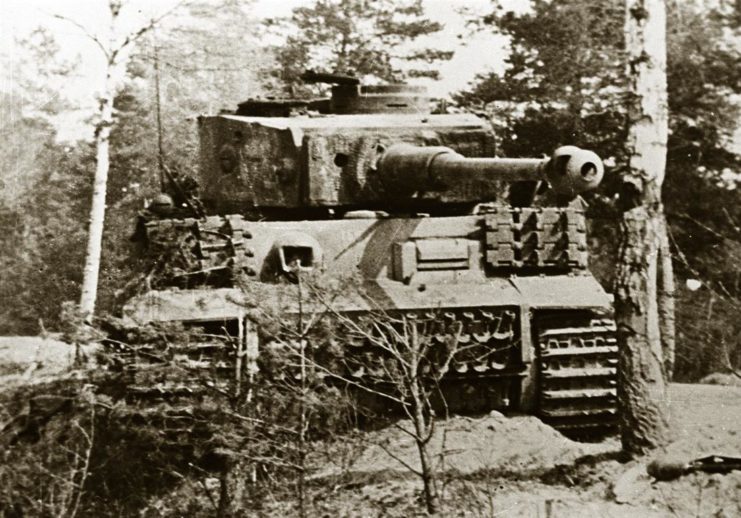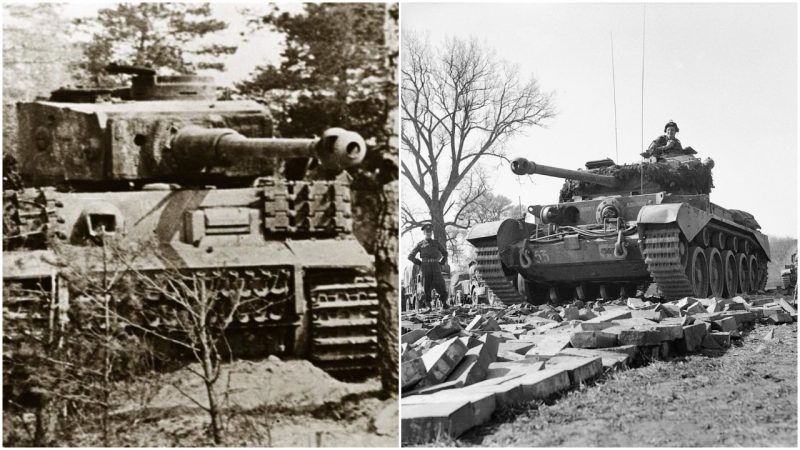In the wooded countryside close to the Aller River in Germany, a small action took place between a lone Tiger and Comet tanks belonging to 3rd Royal Tank Regiment in 11th Armoured Division.
The action took place in April 1945, close to the end of the war. Indeed by this time scattered German units were fighting where the opportunity occurred, not always under any sort of organised control. Instead small enemy parties were being encountered in the woods, often armed with hand held anti-tank weapons or on occasions with actual tanks. One could never be sure when it might happen so it paid to be on the alert at all times.
Kampfgruppe Schulze
As an example Major Paul Schulze decided to form Kampfgruppe Schulze using six Tiger tanks from the Tank School and five Panther tanks from Aufstellungsstab Lehrtruppe, all that remained of the Panzerlehr demonstration division which had been based at Fallingbostel. Their first collision was with the British 6th Airborne Division, which accounted for four of the Panthers and one Tiger hit in the turret by a PIAT so that it was unable to traverse. Then they encountered leading elements of 5th (US) Armored Division which accounted for the last Panther and two of the remaining Tigers.
Of the other Tigers one was hit and knocked out so that in the end only the one Tiger, now commanded by Major Schulze himself, was still in fighting trim. It disposed of some tanks and a few American lorries but it was running out of fuel and in the end was blown up to prevent it from falling into Allied hands and the crew went on their way, on foot. And that was the end of Kampfgruppe Schulze.
Franzen in command
Meanwhile the Tiger that was hit by a PIAT was escorted off the battlefield and under Unteroffizier(Sergeant) Erich Franzen, was sent off to Fallingbostel to be repaired. The workshops at Fallingbostel did what they could to fix it, and now with Sergeant Franzen in command, not realising that they were effectively behind Allied lines, set out to see what it could do. It was an odd tank, fitted with resilient steel road wheels, surmounted by a turret with a drum shaped cupola: a combination that was once believed to be impossible. Although the precise date of this sortie does not appear to be recorded, it was somewhere between the 11thand 14th April 1945, less than a month before the war in Europe came to an end.

Being effectively on its own, Franzen’s Tiger was attached to another Kampfgruppe but this was a rather mixed affair with Marine and Luftwaffe elements. Not regarded as a first line formation capable of confronting an Allied division, it was to be used instead for opportunist actions, such as an ambush. Setting out on the morning of 12 April the Tiger followed a track, leading to a forest, when it encountered Comet tanks of A Squadron, 3rdRoyal Tank Regiment, the leading troop of which was No. 1 Troop, commanded by Lieutenant Johnny Langdon.
Confrontation with a Comet
Britain’s latest tank, the Comet, was still no match for the Tiger, especially in terms of armour protection. Where firepower was concerned it was fitted with a shortened version of the 17 pounder gun which could certainly penetrate the Tiger, although the latter’s 88mm weapon was still very effective in that respect. Where the Comet did have an advantage was in terms of mobility but that was unlikely to be of much use in the existing circumstances.
When Langdon spotted the Tiger it was about 600 metres away. Langdon’s tank got the first shot in but since it didn’t appear to do anything, and the Tiger’s 88mm gun was slowly swinging his way, Langdon ordered his driver to reverse into the trees, and get out of the line of fire. As he did so the German tank turned its attention to another Comet that was reversing off the road. It was hit three times, the crew bailed out but the tank was a write off. After firing a few more shots down the road and destroying at least two other vehicles Franzen’s tank withdrew for the night.
The next morning, when 3rd RTR was starting to move off, what did Langdon see but the same Tiger, sitting in the middle of the road and waiting for them. This morning it was Sergeant Harding’s turn to be the lead tank. They had pulled off the road for the night, so taking advantage of the trees Harding advanced until the Tiger was on his flank. Franzen knew he was there and was attempting to traverse his gun to deal with him, when a round from Harding’s tank penetrated the side armour of the Tiger’s hull and set it on fire.
The crew escaped and Franzen was most impressed that the British tanks let the men get away and didn’t machine-gun them, as they were perfectly entitled to do. Thus, with the war in Europe almost over, one more Tiger tank was knocked out and could no longer pose a threat to Allied armour.
A message from The Tank Museum:
“Please Support Us: As a charity, we rely on public support for all our activities. Our work is funded entirely by people like you. With your support, we can continue to create content. With the right support we might be able to do it more regularly – and can be even more ambitious. Please Click on the Banner Below.”
Thanks to the Tank Museum for this Blog, which originally appeared here.

